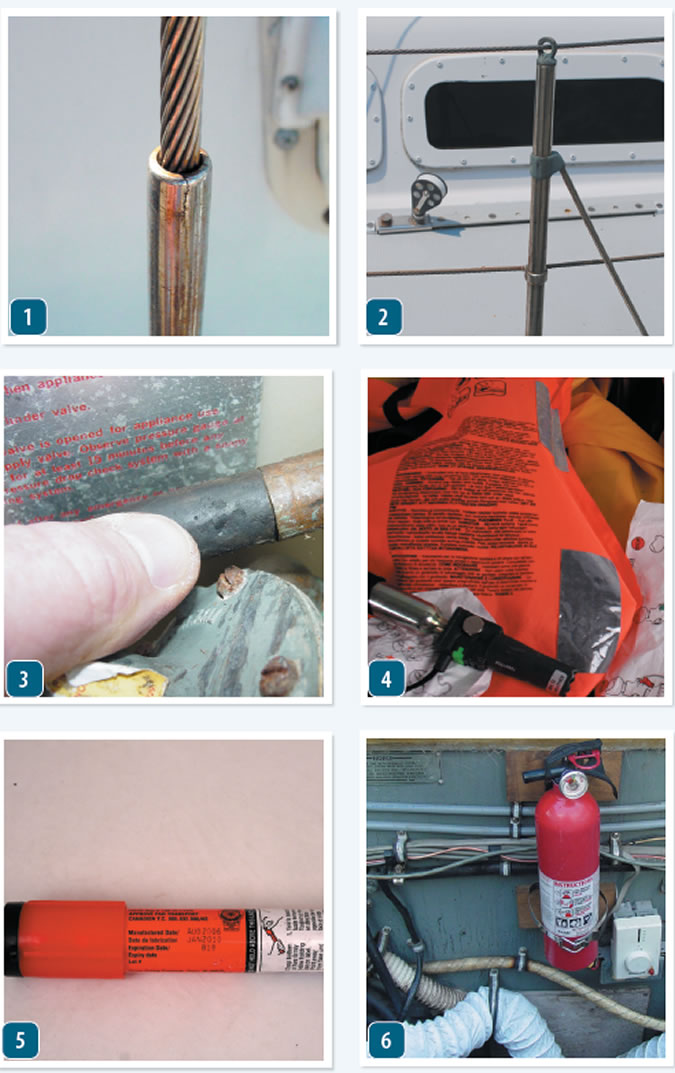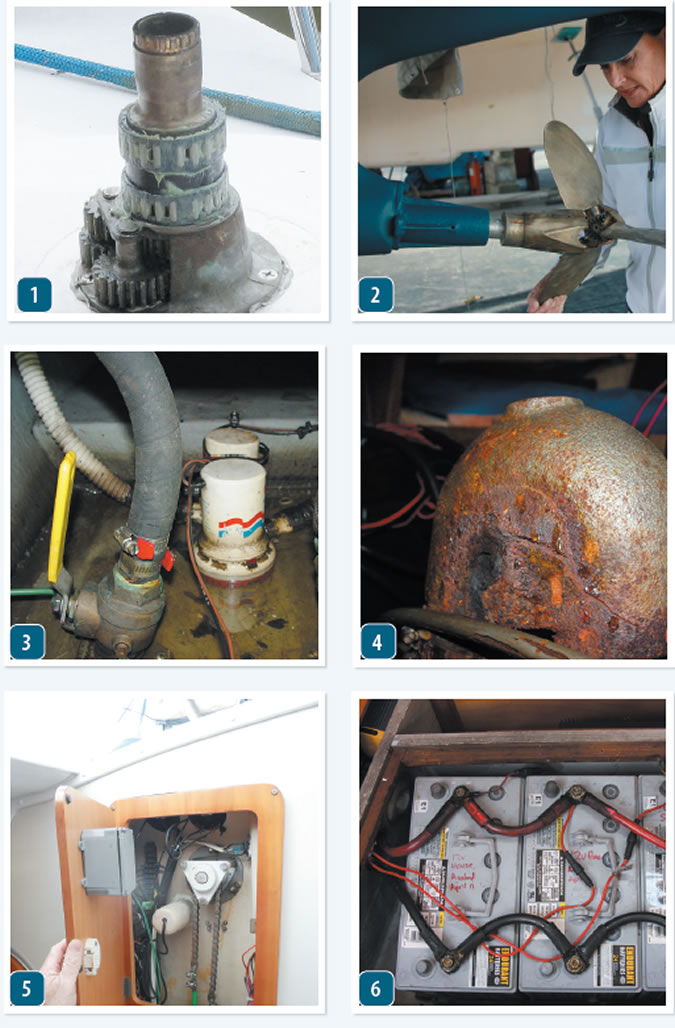Spring is here. Time to step back, put on your inspector hat, and approach the boat as an independent hired inspector would.
Be prepared to tell yourself things you don’t want to hear. Some items relate to maintaining value, some to safety, and some give peace of mind. Some items will require either hauling out or diving. Unless you are extremely experienced with boats and a dab hand at most crafts, hiring a surveyor every 5 to 10 years to catch what you missed is smart money. Your insurance provider may require this.
Deck, Topsides, and Cockpit
- Deck and deck core: Examine visually for moisture penetration and delamination. Tap with a phenolic hammer or the base of a screwdriver.
- Trampoline (multihulls): Check the lacing, bolt ropes and grommets for wear. Are there periodic tie-offs to prevent zippering if the line fails?
- Deck fittings, including cleats and chain plates: Inspected individually for soundness, water-tightness, corrosion and damage or wear.
- Hatches, lockers, and lazarettes: Look for damage to hinges and gaskets, and evidence of leaks. The most common cause of leaks is dirt between the gasket sealing faces, so carry a wet rag and bowl of water so you can clean them as you go. Empty each locker to inspect the locker and take inventory. Remove unnecessary gear. Inspect the stuff you keep.
- Transom: ladders, through hulls, and drains. ABYC standards call for a ladder with lowest rung at least 21-inches below the water.
- Lifelines: Inspect soundness of the pulpit, stern rail, and stanchions. Is the wire corroded at the fittings or where it passes through stanchions? Are Dyneema lifelines chafed? Inspect all gates for secure locking.
- Jacklines: Replace the line if worn or UV damaged. Replace lashings annually. Are there hard clipping points for secondary jacklines or workstation clip-in points for two thirds of the crew?
- Sheeting systems: Inspect traveler, headsail leads and track, twing lines, vang and preventers.
- Mast winches, deck winches and fairleads: Is there a good backing plate? Any evidence of spider cracks around fasteners? If the winches have not been serviced in more than five years, carefully dissemble, clean, and relubricate with either winch grease (Lewmar has best anti-corrosion test results) or Green Grease (Omni Lubricants). Do not over grease and use only oil on the pawls. Replace the pawls and springs if worn.
- Helm station: Play in the wheel? Engine controls working well? Seat well secured?
- Dodger, bimini and other canvas attachments: Inspect frame for loose fittings and cracks. Inspect canvas for chafe. Inspect all stitching and repair. Lube zippers.
Mast and Rigging
- Mast, boom and poles: Inspect halyards before climbing and replace as needed. Climb the mast annually to inspect the rigging. Inspect for cracks, loose fittings and mousing wire.
- Test all internal reefs: Lines can tangle or twist, and birds or rodents can build nests inside the boom.
- Test furler operation: Can you feel any clicking vibrations, as though bearings are failing? Check luff tension, furling line.
- Rigging wire: Inspected for broken strands, cracked terminals and chafe. Are wires well secured to spreader tips? Chafe boots on spreader tips
- Turnbuckles: Secured? Cotter pins or circle clips taped or guarded?
- Eye terminals: Checked for corrosion, cracks and elongation.
- Mast in column: Prebend, if applicable, should be consistent and within specification.
- Rigging tension: Check with tension gauge or by other means. Also check under way in strong conditions; the leeward shrouds should not go completely slack and the mast should remain in column. There should be no pumping of the mast.
- Mast pulleys: Inspect.
- Spreaders and fittings: Examine for corrosion, wear or chafing.
- Boom hardware and lines: Inspect reefing lines, cleats and vang.
- Remove all sails for close inspection: Restitch chafed seams before they fail. A stitch in time saves nine.
- Chain plates: Leakage or evidence of corrosion? Even very slight evidence is grounds for further investigation.
Interior
- Sole: Evidence of leaks. Is it time to recoat for wear? Is it time for recoat for wear?
- Galley: All appliances safe and functional.
- Propane storage and system:
– Hoses cracked or chafed?
– Does pressure hold for a least several hours?
– Check solenoid switch cut-off.
– Test sensors with lighter (no flame).
– Propane locker is sealed and the only drain is overboard? Is drain is above waterline? Spray water through drain to check for clogs. All hose and wire penetrations must be sealed. Nothing may be stored in the locker.
– Check LPG tanks in inspection date and condition.
- Cabin and sleeping accommodations:
– Can furnishings, doors, drawers and interior storage areas be secured against knock-down?
– Dampness or mold under mattresses or cushions?
– Condensation on cold surfaces?
– Are bunks safe in rolly conditions (lee cloths etc.)?
- Carbon monoxide detector: Vital if you ever sleep with the heat on.
- HVAC: Check function.
Engine and Engine Room

- Engine beds and mounts.
- Inspect all hoses and wires.
- Fuel, oil, coolant fluids, exhaust.
- Drive train and couplings.
- Shifting difficulties.
- Sample fuel tank bottom. Water? Test pH (below 5.5 pH suggests bacteria might be present).
Bilge
- Clean. Remove debris in the bilge.
- Test pumps and switches.
- Thru-hulls and thru-hull fittings, including valves, clamps, and hoses. Double clamps below the waterline, no corrosion.
- Fuel system. This includes tank and mounts, fuel lines, filter and shutoff.
- Holding tanks and water tanks. This includes mounts, hoses, and shore connections.
- Keel bolts: Leakage, corrosion, ANY cracking around the bolts. Is a backing plate needed?
- Keel: Damage or signs of repair on the bottom or leading part of the keel are common in boats sailed in shallow water; evaluate the severity of the damage.
- Swing keels: Use a flashlight to look into the keel housing. Inspect pendant if accessible. Check lateral play. Get a pros opinion if play is excessive.
- Cleanliness: Dirty bilges lead to clogged sump pumps and, if nothing is done, sinking boats. There must be zero debris.
Hull
- Check signs of blistering. Minor gelcoat blistering usually isn’t something to worry about, as most boats will develop some blistering over the years. However, severe, deep blistering can be problematic and can be costly to repair.
- Through-hulls, grills, sea valves: All through-hull openings will be inspected for a variety of possible problems resulting from damage or normal degradation and wear. Repeat inspection in the spring if exposed to sub-freezing temperatures.
- Propeller, shaft, and supporting struts: The prop should be sound, the shaft straight and true, and supports strong and sturdy without excess looseness.
- Steering:
-Rudder. Easy, smooth rudder motion.
-Any looseness or wear in the pintles and gudgeons, or bearings.
-Water seepage into the rudder.
-Rudder kick-up and lock-down mechanisms.
-Check tiller for cracks and splits.
-Wheel, cables, and quadrant.
-Autopilot.
Anchors and Ground Tackle
- Chain. Inspect for rust or damage: Run the full length out. Inspect links for wear.
- Shackles: All shackles moused.
- Chain-to-rope splice: Is the splice worn or the end link of the chain corroded (cut off last link and re-splice).
- Snubber: Check for chafe. Is it long enough (about one boat length)?
Electrical
- Installation: Is the equipment installed in compliance with industry practices?
– Fuses or breakers match loads?
– No branch lines smaller that 16 AWG (except for <8-inch leaders to
equipment.)
– No wires twisted onto terminals—ring terminals only.
– Terminals guarded? If a switch or breaker panel back is in a locker, is the locker empty or properly guarded?
Shore power cord: No signs of overheating (check plugs for heating under full load) or burn marks between tines.
- Operation: Does all electrical equipment function properly?
- Batteries: Are they well-secured?
– Corrosion on posts? Clean and coat with waterproof grease.
– Are all circuits properly protected with breakers for fuses?
– Are the positive terminals insulated or guarded?
Plumbing
- Seacocks, hoses, fittings: Seacocks operational?
– Below the waterline seacocks have double hose clamps. Clamps in good condition and not corroded. Clamps properly positioned.
– Hoses not cracked.
- Head: Check toilet, sink, faucet, shower, drain, pump.
- Taps: Do all interior and exterior taps, faucets, and sprayers operate properly, and is there any leakage?
- Sink and faucet: Check for leaks. Does the pressure pump cycle on without demand? Repeat inspection in the spring if exposed to sub-freezing temperatures.
Safety Equipment
- USCG requirements:
–PFDs (personal flotation devices).
-Fixed and portable fire extinguishers.
– Visual distress signals.
– Sound-producing devices (audible signals).
– Navigation lights.
– Engine exhaust blowers and engine room ventilation.
– Oil discharge and garbage disposal placards.
- Auxiliary safety equipment:
– VHF radio.
– Smoke detectors and carbon monoxide detectors.
– First aid kits.
– Fire blanket and water bucket.
– Flashlights/spot lights.
– Check operation of all safety gear.
– At least one head lamp.
– Spare batteries.
– Safety harness. Inspect for wear, specifically near buckles. Inspect carabiners for smooth operation. No binding due to corrosion is acceptable.
– LifeSling. Is the cover closed? Is the sling stored properly? Is the line damaged by UV or chafe? Pull out and re-pack.
Ship’s Papers
- Check for documentation.
– Vessel registration and hull numbers. Dinghy also, if powered.
Drew Frye is for Practical Sailors technical editor and author of Rigging Modern Anchors (Seaworthy Publications). He also blogs at his website.

The list of safety-related inspection points extends to essential gear such as rigging and lifelines, which, should they fail, can put the crew in jeopardy.
- Because they can hold water, deck level swage fittings are more vulnerable to cracking from crevice corrosion or freezing.
- Lifeline chafe is often hidden inside the stanchion. Also check lifeline swage fittings.
- Chafe points on propane lines can eventually wear through the reinforced hose to develop leaks.
- In addition to checking and updating the auto-inflation mechanisms on your PFD, you should check the bladders for leaks by leaving them inflated overnight.
- Flares and other pyrotechnic signals have an expiration date. Because of the high failure rate, out of date flares should not be relied upon.
- Fire extinguishers should be checked for proper pressure. Also confirm the correct location. Extinguishers should not be stored in the engine space or galley, but nearby.

The list of checkpoints increases with the number and complexity of systems. Auxiliary engines present their own inspection points. Electrical systems and plumbing introduce multiple points of potential failure if neglected.
- Winches need to be inspected regularly. Under normal use, you should not have to repack but once every 2-5 years.
- Propellers shafts and bearings need to be checked for excessive lateral movement indicating wear. Folding props need waterproof grease.
- Bilges need to be clean. Check bilge pumps for actual flow rate at the through hull. Check thru-hull valves for smooth opening and closing.
- Engine exhaust elbows corrode and crack with age. Check for leaks here and replace if necessary.
- Steering linkages and chains need to be inspected for wear. Autopilot drive units checked for operation
- Batteries need to be topped off with a charge, and positively secured. Positive terminals should be covered to prevent shorts.
This article was published on 22 March 2019 and has been updated.





































